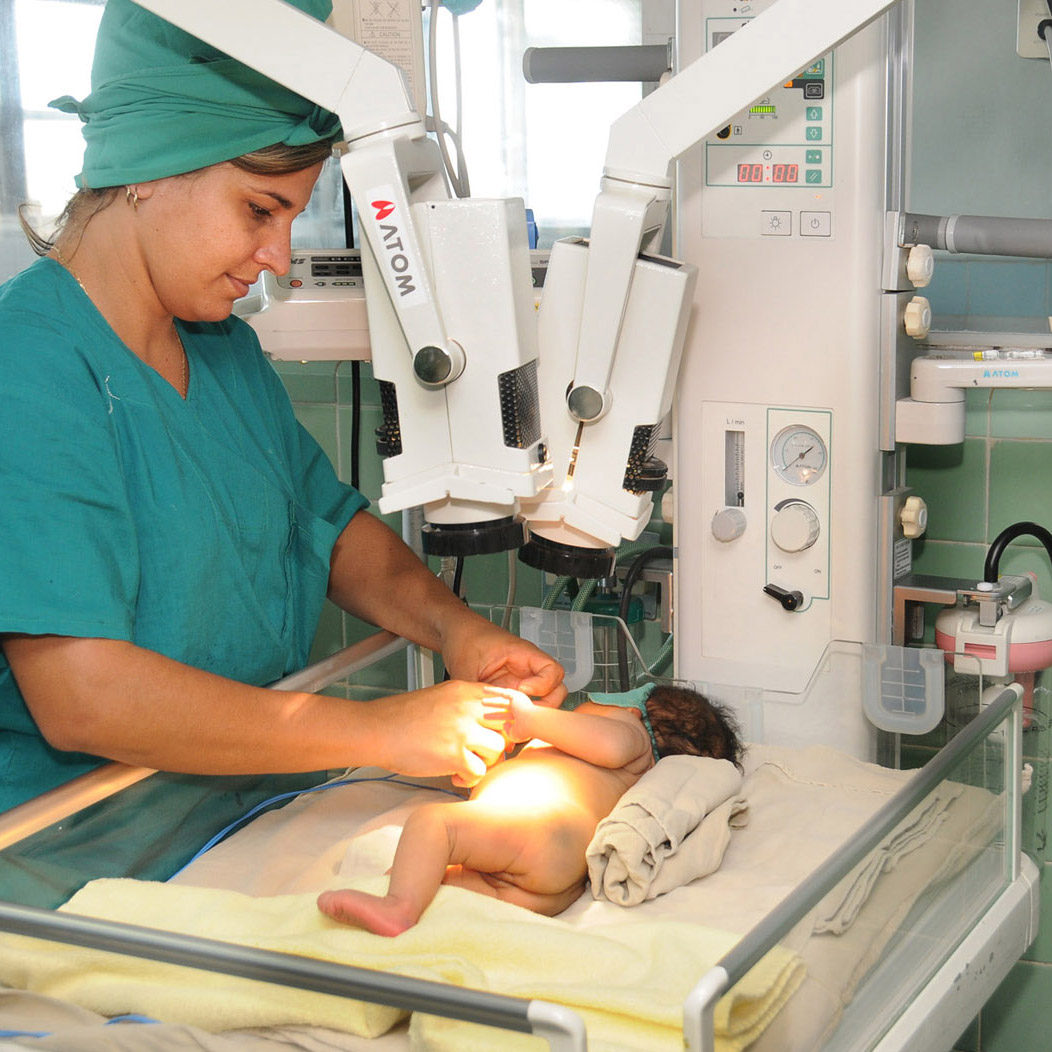Quality of care according to the Pediatric Risk of Mortality Score (PRISM III) in pediatric intensive care units
Keywords:
HEALTH CARE QUALITY, ACCESS AND EVALUATION, INFANT MORTALITY, PEDIATRIC INTENSIVE CARE UNITS.Abstract
Introduction: mortality prediction scores allow the interpretation of information derived from the clinical practice; which facilitates the estimation of success in diagnosis and the choice of a particular therapy.
Objective: to assess the quality of hospital medical care through the scale of risk of pediatric mortality in intensive care units.
Method: A prospective, transversal and analytical study of technological evaluation and development was conducted. 680 children admitted from November 2013 to August 2015 were included in the study; the sample was taken intentionally, based on inclusion and exclusion criteria. The SPSS 11.1 program for Windows was used to determine the data, and to calculate the descriptive statistics: measures of central tendency (mean) and dispersion (standard deviation). The variables were analyzed using the chi-square association test (X2). The specificity and sensitivity of this pediatric mortality score were calculated. A value of p <0.05 was considered significant for all tests.
Results: 57.2% were male, 53.2% were under 5 years old, followed by 34.4% between 10 and 18 years, respiratory diseases (31.1%) prevailed, and it was the most common disease at admission. Out of the total of patients studied, 642 presented favorable evolution, 53.8% were eutrophic. According to the prognostic scale, 72% of the cases showed low risk of death.Conclusion: malnutrition increases the probability of death and that the prognostic score used is a useful and necessary tool because it predicts in a high percentage the risk of dying, which showed greater specificity than sensitivity.
Downloads
References
1. Jabaloyes Vivas JM. Concepto de Calidad [Internet]. España: Universidad Politècnica de València;2010. Disponible en: https://riunet.upv.es/handle/10251/8291
2. Peña F. Conceptos fundamentales de la calidad en salud. Blog Calidad y Excelencia. [Internet]. 2015 Jun Disponible en: https://www.isotools.org/2015/06/29/conceptos-fundamentales-de-la-calidad-en-salud/
3. López Sánchez I, Torres Esperón M, Casanova González MF, Martínez Barreto E. Diseño de criterios, indicadores y estándares para evaluar calidad de la atención de enfermería en servicios pediátricos. Rev Cubana Enferm [Internet]. 2012 mar-jun [citado 24 Dic 2016];28(2):[aprox. 11 p.]. Disponible en: http://scielo.sld.cu/scielo.php?script=sci_arttext&pid=S0864-03192012000200006&lng=es&nrm=iso&tlng=es.
4. Peña Quijada AE, Chang Cruz A, Pardo Núñez AB, Tamargo Barbeito TO, Jiménez Paneque R. Evaluación del pronóstico de mortalidad por los índices de gravedad APACHE II y IV. Revista Cubana de Medicina Intensiva y Emergencias [Internet]. 2012 [citado 24 Dic 2016];12(1):[aprox. 7 p.]. Disponible en: http://www.bvs.sld.cu/revistas/mie/Mie112%20HTML/03112.pdf.
5. Terradillos Martín E, Duque González P, Fernández-Quero Bonilla L. ¿Podemos predecir el pronóstico del paciente crítico? Parte 2 Escalas Pronosticas en Unidades de Cuidados Intensivos [Internet]. Sociedad Española de Anestesiología y Reanimación 2016 Jun [citado 24 Dic 2016]. Disponible en: http://www.cuidados-intensivos-sedar.es/manual-cuidados-intensivos/podemos-predecir-el-pronostico-del-paciente-critico-parte-2-escalas-pronosticas-en-unidades-de-cuidados-intensivos.
6. Earle M, Natera O, Zaslavsky A, Quiñones E, Carrillo H, González E et al. Outcome of pediatric intensive care at six centers in México and Ecuador. Crit Care Med [Internet]. 2012 [citado 12 Nov 2016];25(9):[aprox. 10 p.]. Disponible en: https://www.ncbi.nlm.nih.gov/pubmed/?term=Outcome+of+pediatric+intensive+care+at+six+centers+in+M%C3%A9xico+and+Ecuador.
7. Gómez Hernández PE, Cruz Lara I, Borbolla Sala ME. Score PRISM y Anión gap sérico predictores de mortalidad en la UTIP de un hospital pediátrico. Salud en Tabasco [Internet]. 2013 ene-abr [citado 12 Nov 2016];19(1):[aprox. 07 p.]. Disponible en: www.redalyc.org/pdf/487/48727474002.pdf.
8. More Huamán L, Ramírez Larriviery JC. Hipoalbuminemia como predictor de mortalidad en pacientes pediátricos críticos del hospital regional Cayetano Heredia - Piura período 2009 – 2013 [Tesis para obtener el título de médico cirujano]. Perú: Universidad Privada Antenor Orrego; 2014. Disponible en: http://repositorio.upao.edu.pe/bitstream/upaorep/477/1/MORE_LIBNY_HIPOALBUMINEMIA_MORTALIDAD_PACIENTES_PEDIATRICOS.pdf.
9. Da Fieno JT, Paredes L, Santos Benavides A. Riesgo de muerte en la unidad de cuidados intensivos pediátricos: Uso del PRISM. Rev. peru. pediatr. 2008 [Internet]; [citado 12 Nov 2016]61 (1): [aprox. 20 p.]. Disponible en: https://www.researchgate.net/profile/Jose_Tantalean_Da_Fieno/publication/242531619_Riesgo_de_muerte_en_la_unidad_de_cuidados_intensivos_pediatricos_Uso_del_prism_Risk_of_death_in_the_pediatric_intensive_care_unit_Prism_score/links/0a85e537a0ff38ee4d000000/Riesgo-de-muerte-en-la-unidad-de-cuidados-intensivos-pediatricos-Uso-del-prism-Risk-of-death-in-the-pediatric-intensive-care-unit-Prism-score.pdf
10. Fernández Ariel L, Arias López MP, Ratto María E, Saligari L, Siaba Serrate A, de la Rosa M et al . Validación del índice pediátrico de mortalidad 2 (PIM2) en Argentina: un estudio prospectivo, multicéntrico, observacional. Arch Argent Pediatr [Internet]. 2015 Jun [citado 23 Nov 2016];113(3): [aprox. 9 p.].Disponible en: http://www.scielo.org.ar/scielo.php?script=sci_arttext&pid=S0325-00752015000300006&lng=es. http://dx.doi.org/10.5546/aap.2015.221.
11. Canonero I, Figueroa A, Cacciamano A, Olivier E, Cuestas E. Validación de los puntajes de mortalidad PRISM y PIM2 en una Unidad de Cuidados Intensivos Pediátricos de Córdoba. Arch Argent Pediatr [Internet]. 2010 Oct [citado 04 nov 2016];108(5):[aprox. 11 p.]. Disponible en: http://www.scielo.org.ar/scielo.php?script=sci_arttext&pid=S0325-00752010000500008&lng=es.
12. García Hernández I. Nuevos marcadores pronósticos en el niño críticamente enfermo [Tesis programa de doctorado: avances en pediatría 2005-2006] España:Universidad de Oviedo; 2012. Disponible en: http://dspace.sheol.uniovi.es/dspace/bitstream/10651/12899/2/TDIreneGarciaHernandez.pdf.
13. Guigñan, O., Centritto, C., Arias, F., & Reyes, Á. (2007). Aplicación de la escala de riesgo de mortalidad pediátrica (PRISM) en una Unidad de Terapia Intensiva Pediátrica Venezolana. Archivos Venezolanos de Puericultura y Pediatría, 70(4), 126-129. http://www.svpediatria.org/repositorio/publicaciones/2007/70Octubre-Diciembre.pdf#page=30

Published
How to Cite
Issue
Section
License
Authors who have publications with this journal agree to the following terms: Authors will retain their copyrights and grant the journal the right of first publication of their work, which will be publication of their work, which will be simultaneously subject to the Creative Commons Attribution License (CC-BY-NC 4.0) that allows third parties to share the work as long as its author and first publication in this journal are indicated.
Authors may adopt other non-exclusive license agreements for distribution of the published version of the work (e.g.: deposit it in an institutional telematic archive or publish it in a volume). Likewise, and according to the recommendations of the Medical Sciences Editorial (ECIMED), authors must declare in each article their contribution according to the CRediT taxonomy (contributor roles). This taxonomy includes 14 roles, which can be used to represent the tasks typically performed by contributors in scientific academic production. It should be consulted in monograph) whenever initial publication in this journal is indicated. Authors are allowed and encouraged to disseminate their work through the Internet (e.g., in institutional telematic archives or on their web page) before and during the submission process, which may produce interesting exchanges and increase citations of the published work. (See The effect of open access). https://casrai.org/credit/


